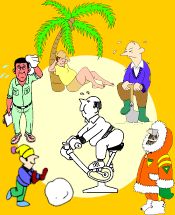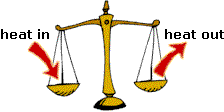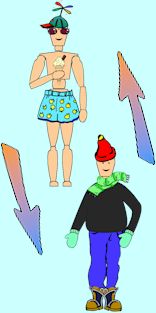|

|
 |
What
temperature is 'comfortable'?
A suitable physical climate is
needed if you are to feel comfortable and to be efficient at work. The environment
feels comfortable when
you are barely aware of the climatic conditions. It is only when the temperature decreases or increases beyond
your comfort limits that you become aware of discomfort.
For temperature, the comfort zone is
about 20-22ºC for a clothed person in the winter, and
20-24ºC in the summer. An increase in temperature above the comfort level may
make you tired and sleepy. A decrease in temperature may make you
restless and less attentive. People vary in their feelings about what is a comfortable
temperature, and this depends on what they are doing and what they are
wearing. If you are running in an overcoat, you will feel hotter than if
you are sitting still in your underwear, even if you are in the same
room!
Age and gender can also make a
difference. Old people, people with disabilities, babies and young children typically feel more comfortable at higher temperatures.
Women notice that they are feeling cool quicker than men, which may be related to their different body size, but is also related to a difference in the
how quickly women respond to changes in temperature. Women reduce the blood flow to their arms, hands and feet faster
than men if they cool down, resulting in colder fingers and toes. This
reduction in blood flow is a way of regulating body temperature.
|

|
|
Body temperature regulation |
| Regulation
of your body temperature is called thermoregulation. In a neutral climate, at rest,
your body regulates its temperature to around 37°C. This is by no means an exactly fixed temperature for all humans. When measured in the morning after
bed rest, the average temperature of a large group of people will be around 36.7ºC, but individual values of healthy people will range from 36 to 38ºC. During the day,
your temperature will increase, typically by about 0.8°C, peaking in the late
evening. It will drop again until early morning due to the circadian rhythm (changes
in bodily functions over the course of the day and night). Also, exercise will cause an increase in body temperature, with temperatures around 38°C typical for moderate work and values up to 39°C and occasionally above 40°C for heavy exercise,
for example, marathon running. Increases by exercise up to 39°C
are seldom a problem to the body and are considered as normal in thermoregulation.
Heat Balance
When your body is not
stressed by the temperature around it, its own temperature is quite stable. This is achieved by balancing the amounts of heat produced in
your body with the amounts lost, and ensuring that the amount of heat stored in
your body is stable.
|
| Heat is produced in
your body by metabolic (chemical) processes, such as
absorbing nutrients
and performing muscular work. When at rest, your body needs all
this heat to enable its basic functions to work properly. For
example, to provide
your body cells with oxygen and nutrients during breathing and
digestion. |
 |
Your
body has several ways of losing heat. A minor role is taken by
conduction - heat loss through contact with fluids or
solids. Conductivity only becomes a relevant factor for people working in water, in special gas mixtures (prolonged deep-sea dives), handling cold products or lying
still (for example on an operating table).
|
| When working however, the active muscles
need more oxygen and nutrients, and your metabolic activity, and
therefore heat production increases.
In the cold, automatic closing
down (constriction) of the blood vessels is not enough to maintain your
temperature. Shivering produces additional heat. Opposing muscle
groups are made to work against one another. This increase in
activity increases the metabolic heat to between 2 and 4 times what it
is at rest. Shivering is not enough to heat you up - it can only
stop you from cooling down. The better physical condition you
are in, the better you at maintaining shivering without tiring, and
therefore the better you would be at surviving cold stress.
Your body also needs to get rid of
any excess heat it produces, otherwise it will warm up to lethal levels. For
example, if no cooling were possible, and you worked at moderate levels (metabolic rate 450
watt; the equivalent heat production of six 75 watt light bulbs),
your body temperature would increase by around 1°C every 10 minutes.
|
More important for heat loss is convection. When air flows along
the skin, it is usually cooler than the skin. Heat will therefore be transferred from the skin to the air around it.
Also heat transfer through electro-magnetic radiation can be substantial. When there is a difference between
your body's surface temperature and the temperature of the surfaces in the environment, heat will be exchanged by
radiation.
Finally, the body possesses another avenue for heat
loss - by evaporation. Due to your body's ability to sweat, moisture appearing on
your skin can evaporate and large amounts of heat can be dissipated from
your body.
Apart from convective and evaporative heat loss from the skin, these types of heat loss also take place from the lungs by respiration, as
inhaled air is usually cooler and dryer than your
lung's internal surface. By warming and moisturising the inhaled
air, the body loses an amount of heat as the air is exhaled, which can be up to 10% of the total heat
production of the body.
|
|
|
Adjusting to
different temperatures
When you change from one environment to another with
a different temperature,
your body makes certain adjustments to ensure that you maintain a
constant body temperature.
|
 From
warm to cool From
warm to cool
If the loss of heat from your body is greater than heat production, your
body temperature will fall. In order to prevent this, the following changes occur:
- Your blood is directed away from your skin, and more to the central part of your body to maintain the temperature of those parts,
- Your skin becomes cool as a
result of this,
- You get goose flesh, which increases the insulation capacity of your skin as rough surfaces lose less heat than smooth ones,
- You might shiver which activates the muscles in order to produce additional heat,
- You might adjust your behaviour - you might move to a warmer space, put on clothing and change your posture to preserve heat.
Your body may eventually
stabilise in a cold environment. However, in extreme cold, for
example immersion in water after a ship wreck, your body will
cool so much that it is unable to maintain its central
temperature. This may fall below 35ºC, a state known as hypothermia,
and if it falls below 33ºC, the risk of death starts to
increase significantly. At this temperature and below, your heart can have
problems with its rhythm, your mental performance decreases
(often leading to wrong decisions) and your body control is
reduced.
With a cold body, there may be a chance of recovery however. Even if
submersed in cold water without breathing for periods that would mean
certain death on land due to lack of oxygen, people have made full
recoveries. The reason for this is the lower oxygen usage of the brain
when it is cooled. The lowest body core temperature from which full
recovery has been reported is around 14ºC. Of course, chances of
recovery are slim
in such a case.
|
From cool to warm
When you move from a cool to a warmer environment, your body
temperature will increase as:
- More blood is directed to the surface of your body (skin),
- Your skin surface is warmed
as a result (and a result of radiant heat from the
surrounding air,
- Your heart rate and pulse rate increases,
- You may start to sweat,
- You may adjust your behaviour by moving to cooler areas, adjusting your clothing,
reducing activity and changing posture.
Your body eventually stabilises in a warm environment. However, if the
rate of heat gain continues to be greater than the loss, your body
temperature will rise continuously, leading eventually to heat stress,
and in the most extreme cases, to heat stroke. If your temperature rises
to 42ºC, your brain and your nervous system will cease to function and
death will follow.
Note: "Often people who suffer heat stroke are young and energetic
and are under situations involving work-related, military or athletic
pursuits. Frequently they have not felt a particular need to take care
of themselves and have never considered the effects of strenuous
activity undertaken in conditions of high temperature" (from
Occupational Health and Safety July/August 1978).
|
|
Acclimatisation
to heat and cold
Acclimatisation
consists of a series of physiological adjustments that occur when
you are habitually exposed to extreme thermal conditions, hot or
cold. Acclimatisation refers to an ability to endure conditions
with less feeling of discomfort, and an ability to perform work
activities for a longer duration. Acclimatisation to heat involves
a decrease in body core temperature, a decrease in pulse rate and
an increase in sweating. Much of the acclimatisation to heat
occurs within 4 to 7 days and it is usually complete in 12 to 14
successive days of heat exposure. Acclimatisation to cold is much
slower and often less evident. It may take months, and it will not
protect you from extreme cold. |
|
|
Working
in extreme temperatures |
 According to the Offices, Shops and Railway Premises Act 1963, the minimum temperature
at which people should be expected to work is 16ºC. However, this is not a comfortable temperature for light or
seated types of work.
According to the Offices, Shops and Railway Premises Act 1963, the minimum temperature
at which people should be expected to work is 16ºC. However, this is not a comfortable temperature for light or
seated types of work.
The surface temperature of the walls, the windows, the ceiling and the floor should not differ from the room temperature by more than 2 or 3ºC. In some industrial production
processes, workers may be exposed to either very hot (hot-dry or
warm-moist) or very cold environments, for example, furnaces, laundry or textile
dyeing, and the cold storage industry.
Hot conditions usually result in decreased efficiency and in physiological strain
through an increase in pulse and heart rate, increase in skin temperature, thirst,
weariness and faintness. In a hot-dry work environment, the heat often occurs in the form of radiation.
Reducing this involves preventing the heat from falling on you, by wearing protective clothing or screening with aluminium foil. You should move out of the environment regularly to allow time for cooling off,
for example, a 20 minute work period should be followed by a 10 minute
cooling off period. In addition, small quantities of liquid should be drunk continuously to replace fluid lost by
sweating.
In warm-moist environments work becomes difficult because of the high humidity, which reduces
the evaporation of sweat. Ventilation and air conditioning improve the
air quality.
In cold conditions, well-designed clothing
insulates your body and slows down the release of metabolic heat. Your hands and feet
are particularly susceptible to the cold, so they should be covered well so that
manual dexterity and mobility are not impaired.
|
|
|
The
temperature at home |
 According
to some building design regulations, the
temperature at home during the cold months of the year should not be less than
the
following: According
to some building design regulations, the
temperature at home during the cold months of the year should not be less than
the
following:
| Living Room |
21ºC |
| Bedroom |
18ºC |
| Kitchen |
18ºC |
| Bathroom |
20ºC |
| Toilet |
16ºC |
| Corridor |
18ºC |
| Entrance Hall |
14ºC |
This list is based on building design regulations, but in practice different values may be preferred, like a warmer bathroom or a cooler bedroom.
For the elderly, it is important to avoid large contrasts in temperature,
for instance, when moving between one room and another, as this may affect their cardiovascular health.
|
|
|
Problem-solving
|
| Problem |
Result |
Consequences |
Solution |
Optimum
conditions |
 Air temperature
- the surrounding (ambient) temperature of the place
you are working Air temperature
- the surrounding (ambient) temperature of the place
you are working |
| Too high |
The body can't dissipate its heat to the surrounding air.
|
Increase in body temperature, increased heart action, reduced performance, more mistakes made,
drowsiness.
|
Increase room ventilation, induct cool air, exhaust hot air.
|
Light office
work
19-21ºC;
Light factory work
16-18ºC;
General factory work
14-16ºC;
Heavy factory work
12-14ºC. |
| Too low |
The body loses too much heat to the surrounding air.
|
Shivering,
stiffness of joints and muscles, reduced powers of concentration, complaints about draughts (even at low air velocities).
|
Warm the air (heaters, radiators, etc.), supply radiated heat (ceiling or panel heating).
|
 Radiation
temperature - temperature of a source that is higher or
lower than your body temperature, which causes you to feel
hotter or colder Radiation
temperature - temperature of a source that is higher or
lower than your body temperature, which causes you to feel
hotter or colder |
| Too high |
The body absorbs too much heat from the source.
|
As above |
Intercept radiation with sun blinds, double aluminium screens (or in extreme cases
with special clothing), reduce the air temperature.
|
In general, equal to or slightly above the air temperature.
|
| Too low |
The body loses too much heat e.g. to cold walls or windows.
|
As above |
Increase the air temperature.
|
 Air
velocity - air speed, for example, from draughty vents or
windows; particularly felt around neck and ankles Air
velocity - air speed, for example, from draughty vents or
windows; particularly felt around neck and ankles |
| Too high |
Local cooling of the skin.
|
Muscular pains, complaints about draughts.
|
Trace and eliminate cause.
|
Office and assembly shops
0.15m/sec; Standing and walking work 0.15-0.5m/sec. |
| Too low |
Evaporation of sweat is reduced and therefore also dissipation of body heat.
|
Clammy
skin, complaints about stiffness. |
Install ventilators, induct air.
|
 Humidity
- amount of moisture in the air Humidity
- amount of moisture in the air |
| Too high |
Evaporation of sweat impeded.
|
Reduced resistance to high temperatures.
|
Improve ventilation.
|
30-70% relative humidity.
|
| Too low |
Excessive evaporation.
|
Dryness of mucous membranes (of nose and mouth, for example).
|
If necessary, artificially increase the humidity.
|
|
| |
|
|
|
|
|